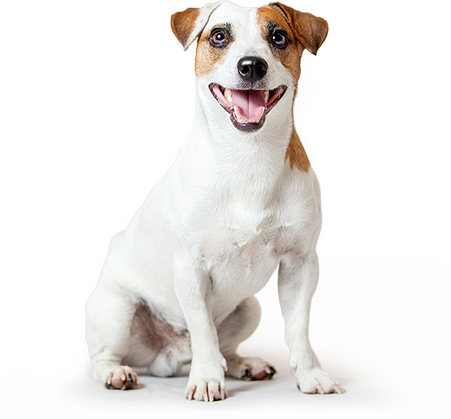- The different ways to travel with pets
- Pet-friendly accommodation
- What to do before you leave
- How to ensure your pet’s comfort

It’s fair to say that your pets are your family, so it’s natural to want to take your furry friends along with you on the next family vacation. Travelling with pets has become a lot easier in recent years, with public transport and even hotels offering pet-friendly services.
DID YOU KNOW?1
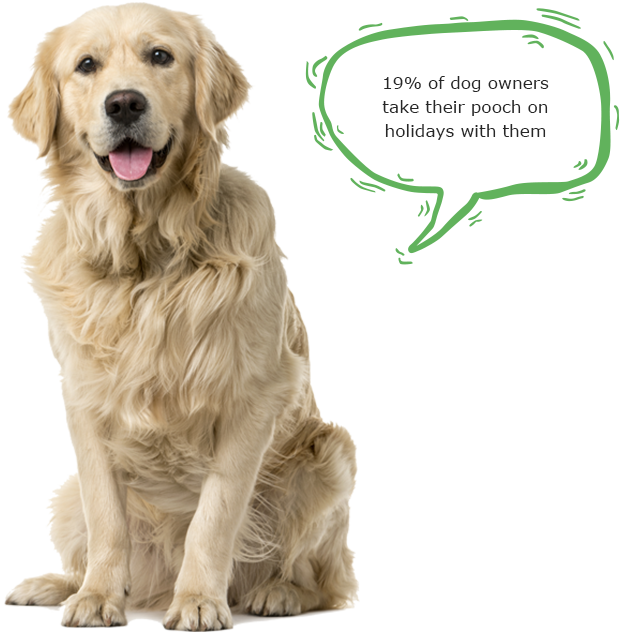
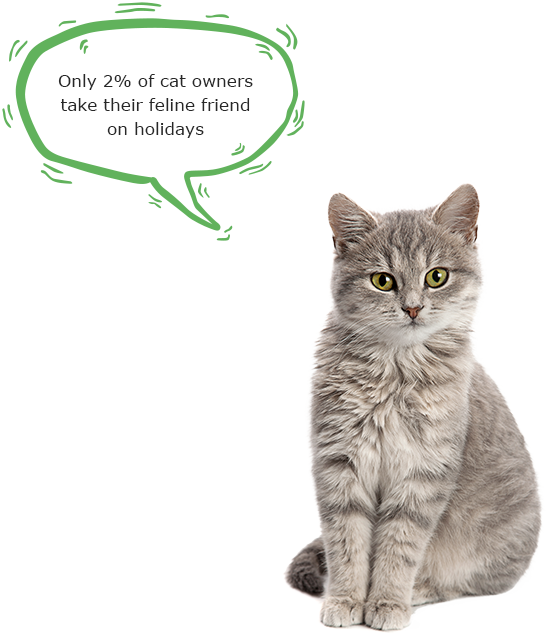

Pet travel can be fun, but it also involves a bit of preparation to ensure a smooth and safe journey for the entire family.
The different ways to travel with pets
Whether you’re holidaying interstate or even overseas, there are different ways your best four-legged friend can travel with you. Travelling with pets isn’t difficult if you do your research and become familiar with all the rules and regulations when it comes to pet travel by public transport. Every state has different protocols when it comes to pet travel, so it’s wise to check your state’s public transport website for more information.
If you’re only going for a short trip (less than 1 month), keep your cat at home. Cats are territorial and easily become stressed – they will be much happier with a pet sitter instead.
Let’s take a closer look at the different types of transport and how you can travel with your pets on them.
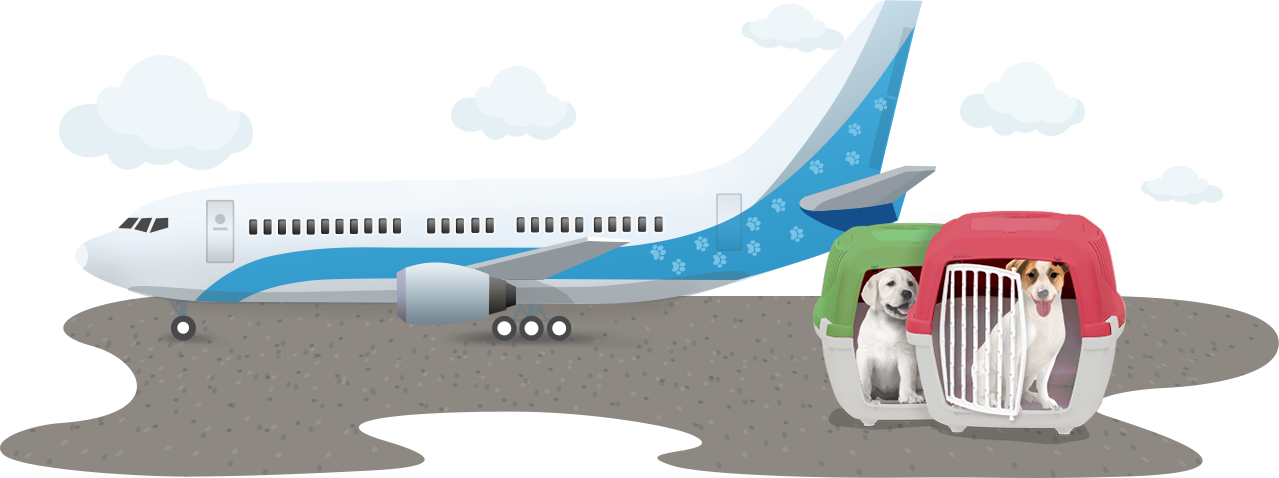
For airlines to accept your pet for travel, they’ll need to confirm that your pet is more than eight weeks old and has had a full health check-up with your vet prior to flying. Your vet will assess whether your pet will need any vaccinations, and will also make sure their flea, tick and worming treatments are up to date. Each airline has different regulations for when you can book your pet’s travel. For example, on Australian domestic flights with Qantas, you can book in your pet to travel at the same time as you book your own flight.
An estimated 2 million pets travel on commercial flights each year, with most of the major airlines accepting domestic and international pet travel. Depending on the airline, your pet can either travel with you in-cabin, or be stowed away in the plane’s cargo hold. Airlines in Australia cater to pets with special pet transport services such as Jetpets and AeroPets. As a precaution, be sure to check the rules and processes for travelling with pets on your chosen flight service prior to booking your tickets. For some, the idea of an airline only allowing cargo travel for pets may be off-putting.
Pet travel on aeroplanes is generally safe, however, it doesn’t come without risk. Just like with lost luggage, pets have been known to become lost or flown to the wrong location. It’s important to do your research on the airline and its policies regarding pet care before you make a booking.
If you’re lucky enough to travel with your dog, there are a few things to keep in mind to ensure the process is safe and simple.
 Make sure your dog has the right temperament
Make sure your dog has the right temperament
Most airlines will not accept dogs with an aggressive temperament, as well as certain breeds of dogs. Breeds such a Pit Bulls and American Staffordshire Terriers are among the most widely-banned on flights.3
High-stress dogs or dogs that are prone to anxiety (including separation anxiety) aren’t recommended to fly, either. Sedation is generally not recommended on flights due to risks to pet health and safety, unless specifically advised by your veterinarian. So before booking that flight, keep in mind the health and welfare of your dog.
 Find a comfortable pet carrier
Find a comfortable pet carrier
Check with your airline about the required dimensions for the pet carrier you’re permitted to carry your dog in, and avoid taking a carrier that’s too small for your pet. If you’re allowed to take your dog in the cabin with you, make sure you’ve filled in the live animal checklist at check-in, and put the live animal label on your dog’s carrier.
You can find airline-approved dog carriers and crates at most quality pet stores, or your vet can recommend a product to suit your animal.
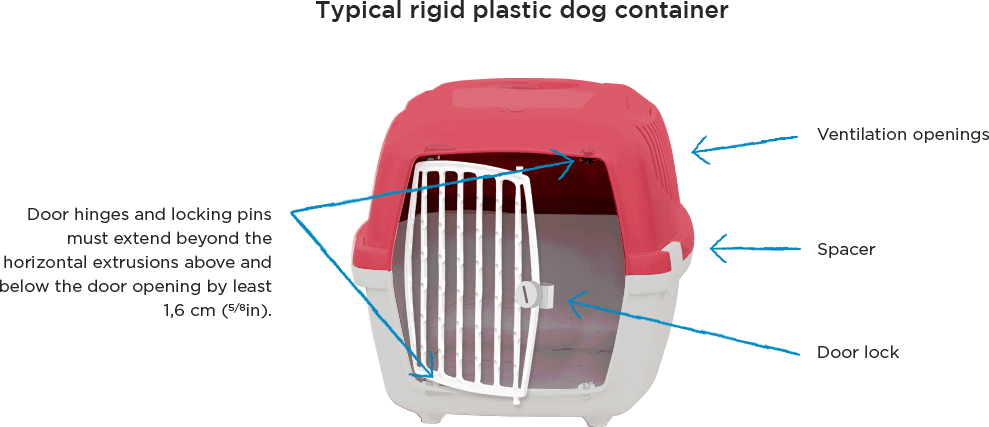
 Pack a ‘doggy travel bag’
Pack a ‘doggy travel bag’
Along with your luggage, you need to pack a bag containing all your dog’s necessities. Be sure to have enough food, toys, and treats for your dog, at least for the first couple of days after you touch-down. Don’t forget to pack any prescription medication and make sure you have enough to last until you return home. If your dog has a favourite toy or object that comforts them, take it with you to help ease any flight anxiety they may be experiencing.11
Remember to pack food and water bowls for your dog once you land. And don’t forget paper towels and poo bags in case any mess occurs during the flight!
 Bring your dog’s health certificate
Bring your dog’s health certificate
In certain circumstances, pets travelling across borders may require a recent vet certificate signed within 14 days from your departure date to declare your pet is in good health and is safe for travel.5 Some airlines require this certificate to be signed within 10 days of travel.3
 On the day of the flight
On the day of the flight
It’s important not to feed your dog too much within eight hours of travel, since it may result in an upset stomach while on the plane, so limit the amount of ‘extra treats’ you may be tempted to give them. It’s also a great idea to take your dog for a longer walk on the day of the flight to allow some exercise and help tire them out so they will be more comfortable while on the plane. Make sure they are well hydrated and have toileting opportunities before the flight.5
Flying is stressful enough for humans, so there’s no doubt your dog may feel panicked too. If they’re being put into the cargo hold, give them a piece of your clothing with your smell on it or a favourite toy in their container to help comfort them on the journey.
The same protocols that apply for dogs also apply when taking your cat on a plane. You may need a recent health certificate from your vet, and advice as to whether you’re allowed to take them in-cabin with you.3
Travelling on a plane can be very stressful for cats, and so you need to prepare well to make their journey as comfortable as possible. It isn’t recommended to transport your cat by air for just a short trip (such as a holiday) due to the stress involved, so only consider air transportation if you are moving cities, states or countries.
 Get your cat used to its carrier in the weeks before travelling
Get your cat used to its carrier in the weeks before travelling
When choosing a carrier, make sure to choose one that adheres to your airline’s regulations.3
After purchasing an approved airline carrier for your cat, encourage them to spend time in it to become comfortable in the confined space. Leave it anywhere your cat frequents, such as its food bowls, bed, or scratching post.12 Consider placing some bedding in the carrier to encourage your cat to sleep in there by choice.
Also consider spraying the carrier with a cat calming spray (such as Feliway®) to help with your cat’s stress and anxiety while on the plane.
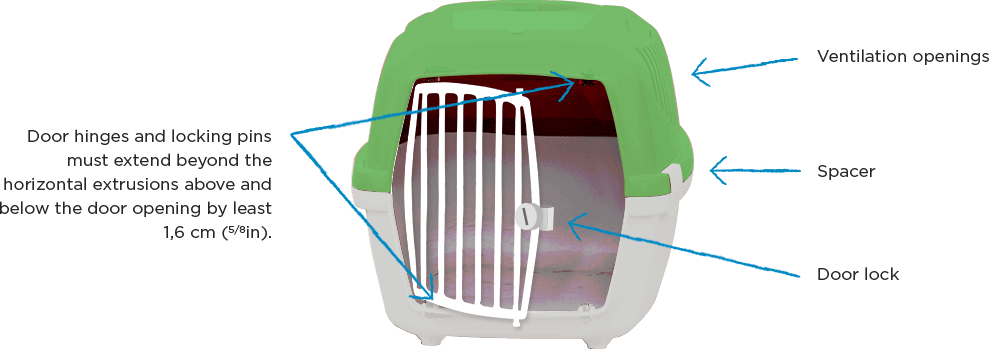
 Trim your cat’s nails
Trim your cat’s nails
Trimming your cat’s nails prior to the flight might be a good idea to save it scratching up the interior of its carrier while on the plane. The nails could become caught in the carrier’s bars, leading to injury. If you’re not comfortable doing so yourself, ask your veterinarian for assistance.
 Get your cat used to loud noise
Get your cat used to loud noise
Plane travel is very noisy, especially in the cargo-hold. To help your cat feel safer around loud noises, turn on the radio in your house and keep it at a low volume so your cat becomes accustomed to background noise.13
Another way to help your cat become used to noise and travel is by taking it with you in the car. Even if it’s just a drive around the block, having them experiencing unfamiliar situations will better prepare them for the motion that comes with plane travel.13
 Snub-nosed cats
Snub-nosed cats
Just like dogs with short noses, many airlines also restrict snub-nosed cats from flying as a health precautions. This includes Persian, Himalayan, and Exotic Shorthair breeds. Because the muzzle is so short in these cats, soft tissue blocks the nose and airways, impeding airflow. The condition is often aggravated by stressful situations, which is the case when travelling. It is not recommended to transport short-nosed cats by air.14

Travelling with your pets in the car is a fun experience, where often your pet enjoys it more than you do. To ensure your holiday or road trip is safe and relaxed for both you and your pet, there are some important tips to keep in mind.
Did you know?
The RSPCA can issue fines under The Prevention of Cruelty to Animals Act. If an animal is injured because it was unrestrained in a vehicle, the owners face up to six months’ jail and fines of up to $5,500. In addition, carrying dogs untethered on the backs of utes can result in drivers receiving fines of $500.15
 Use restraints and carriers
Use restraints and carriers
To reduce the risk of injury to your pet and any distraction from driving, it’s important – and a legal requirement – to keep your pet restrained in the car. Dogs should be restrained using a dog seat belt or safety harness, preferably in the back seat of the car to avoid any potential injury from passenger seat air bags in case of collision. Cats should be secured in a cat carrier or crate with a seatbelt buckled around it.
Ensure adequate airflow by keeping the air-con on to stop your pet from becoming too hot, and under no circumstances leave your pet unattended in the car due to the risk of death from heat stress, even in mild weather.
And despite what you often see, it’s recommended you refrain from having the restraint loose enough to let your dog hang their head out of the window, as if you have to brake hard or swerve to avoid a collision, your dog may become seriously injured.
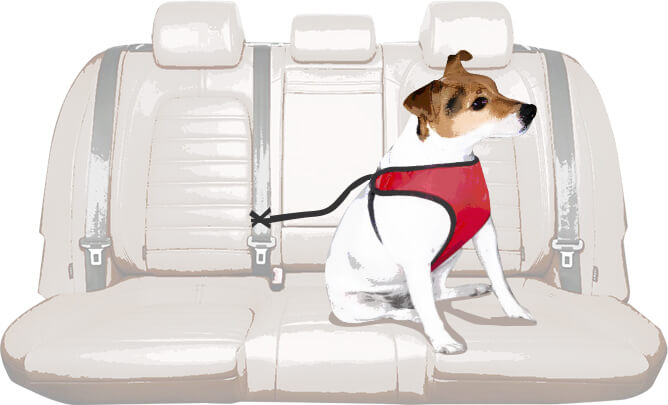
 Bring an emergency kit of treats, toys, and walking gear
Bring an emergency kit of treats, toys, and walking gear
Along with all the necessities for your holiday, you should also take a pet travel bag filled with treats, toys, bottled water, and bowls to use as you travel. Make sure to have your dog’s leash and harness within easy access for when you pull up to get out for a walk and toilet break.
A ‘pooper-scooper’ and plastic bags to clean up after your dog should be brought with you, as well as a disposable litter box if you’re taking your cat.
For cat travel, a good way to prevent any mess and smell is to line your cat’s carrier with an absorbent sheet for any accidents along the way.
 Take extra water
Take extra water
Taking bottled water with you in the car for your pet will help keep them hydrated and is handy when you pull up somewhere where there’s no water or tap access. Just fill up an old ice cream container or travel bowls with the water when you pull over.
For cats, you can purchase water dispensers that attach to their travel carrier so that they can keep hydrated as you travel.
 Get app-savvy
Get app-savvy
Before setting off on your road trip, it’s worthwhile looking at some of the apps available for pet travel. These apps make road-tripping a lot easier for you and your beloved furry pal. For example, Dog Park Finder Plus is great for locating any dog-friendly parks and reserves.
 Take rest stops
Take rest stops
Your dog will need regular stops to get out and stretch their legs, sniff around, and have a toilet break. Aim to stop every two hours, and give your pets some treats and water. Your pet is usually very good at signaling when they need a break, so be aware of their behaviour as you’re travelling to prevent any discomfort or accidents.
 Check identification
Check identification
Identification tags with up to date contact details must be safely secured to your pet in case the worst happens and they become lost. Your pet should also be microchipped with up to date details so you can be contacted as needed.

There are different rules and requirements for different states when it comes to travelling on trains with pets.
In Australian states, pets generally aren’t allowed on trains unless they’re classed as assistance animals. For example, in New South Wales only assistance animals with valid accreditation can travel on trains.17 Accepted assistance dogs include:
- Personal care and mobility assistance dogs
- Guide dogs
- Hearing dogs
- Medical alert dogs
- Psychiatric service dogs
- Animals with a Transport for NSW Assistance Animal Permit
- Animals with an interstate permit accepted by Transport for NSW.
On the Adelaide Metro only accredited assistance animals are allowed on18, whereas in Victoria all dogs can travel on trains outside weekday peak hour so long as they’re on a lead and wearing a muzzle. They must also be kept under control and prevented from sitting on seats or obstructing aisles.19
Cats can travel on metropolitan trains in Melbourne, with special rules and requirements as for dogs. For example, cats are required to be in a pet carrier or crate while travelling on and around the train platform/station.19
For V/line trains, pet travel containers must19:
- Be no more than 56cm long, 30cm wide and 38cm high.
- Weigh a maximum of 15kg, including your animal.
- Allow your animal enough space to comfortably stand up, lie down and turn around.
In New South Wales, no pets other than assistance animals are allowed on trains, train stations and platforms.17

Travelling by bus with your pet is permitted in some states of Australia. For example, in New South Wales your dog or cat can travel with you on the bus with the driver’s permission. Basic etiquette and respect for other passengers are asked of you, meaning that you keep your pet leashed and muzzled, or in a pet carrier for the safety and comfort of your pet and other bus users.17
As another example, in Victoria, only assistance animals are permitted outside of a carrier, while other animals are permitted when suitably contained.19
For V/line coaches, only assistance animals are allowed to travel.19
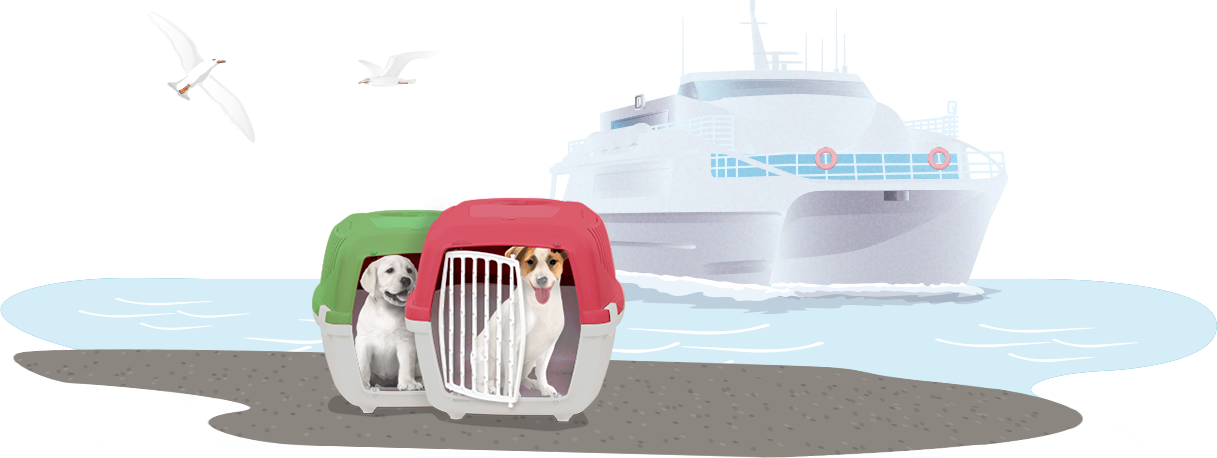
As with the other forms of public transport, the ability to take your pet differs from state to state. For example, if you’re travelling via ferry in New South Wales, your pet is allowed on board with the crew’s permission.17
If your pet is permitted on board, then before boarding ensure your cat or dog is:
- Restrained in an appropriate carrier, crate, or box.
- Of good temperament and doesn’t pose a risk to other passengers.
- Clean and visibly healthy.
- Not left to roam around the ferry or sit on seats or in passageways.
Pet-friendly accommodation
There is plenty of pet-friendly accommodation available in Australia, with every state offering different hotels or pet retreats for you to stay with your dog or cat while away from home.
For pampered pets in NSW
The Langham at The Rocks, Sydney, now caters for you and your pet with rooms that offer plush beds and creature comforts for your cat or dog. There’s a pet room-service menu which sounds so good it could be for humans too. The hotel also offers pet-sitting and walking services for when you’re out and about.
For room to roam in ACT
The Mercure Canberra offers pet-friendly rooms with an adjoining fenced courtyard for space for your pet to roam and play. They also provide a free take-home toy for your pet to remember their holiday.
For unusual pets in SA
South Australia’s Yorke Peninsula offers the Yondah Beach House which caters for pets large and small. Past guests have brought turtles, ponies, and even rats to this farmhouse retreat.
For camping trips in every state
If you love your true Australian camping experience, then head to your destination state’s local Big4 Holiday Park. The majority of Big4’s are pet-friendly and offer enclosed areas for your pet to run and play, as well as other basic amenities to keep your pooch entertained.
What to do before you leave
Before setting off on your next holiday, be it by plane, train, bus or ferry, make sure you check off these important items:
- Take your pet to the vet for a health check-up and get them up-to-date with any immunisations and treatments.
- Book your pet in for a professional cleaning, or clean them well at home.
- Pack a suitcase for your pet. Make sure everything is within easy access, including a leash, toys, food, medications, treats, water, and bedding.
- Keep your vet’s number handy. If anything were to happen, you will want to quickly obtain your vet’s advice. Find out the number of the emergency vet in the area where you will be holidaying and also put it in your phone.
- Ensure you have your pet insurance details just in case anything happens on the road and your pet needs veterinary assistance.
DOWNLOAD OUR FREE TRAVEL CHECKLIST TO PREPARE

By submitting/entering your email address you agree to our Privacy Policy and to us contacting you by email with our latest product offers, articles and more!
How to ensure your pet’s comfort while travelling
Your pet’s comfort will make for a smooth and enjoyable trip. Here are some good takeaways to ensure your pet’s safety before travelling:
- Always carry extra bottles of water to keep your pet hydrated.
- Bring treats with you to keep your pet satisfied and distracted.
- Pack your pet’s favourite toy as it will help them to relax.
- Never leave your pet unattended in the car.
Did you know?1
Australian pet owners spend $520 million a year on pet boarding or minding services.
Take out pet insurance before you leave
With careful thought and planning, travelling on holiday with your pet is lots of fun. With a growing number of hotels and public transport services catering to pets, you’re now spoilt for choice when it comes to pet-friendly travel.
But just like with any form of travel, there are risks involved. Taking out pet insurance is a good way to ensure your pet is protected if something were to happen while on holiday or during travel. You can apply for RSPCA Pet Insurance for your dog or cat, and they’ll be protected from the unexpected.
And we wish you safe and happy travels!
Dr Rosemary’s bio
BVSc (hons) MPsych (clin) BA (hons), MANZCVS (Animal Welfare).
Rosemary studied veterinary science at the University of Sydney after establishing her career as a clinical psychologist. Her experiences during veterinary training fostered an ambition to focus directly on animal welfare and ethics. Rosemary co-founded Sentient, The Veterinary Institute for Animal Ethics, in 2011 and is their current President. She is a member of the Australian and New Zealand College of Veterinary Scientists (Animal Welfare) and promotes animal welfare through advocacy, writing, research and presentations.

Reference Sources
1.Pet Ownership in Australia 2016 – Animal Medicines Australia
2.Travelling with Pets – Flight Centre
3.Household Pet Air Travel Guide – QANTAS
4.Short-nosed Dogs and Air Travel FAQsFrequently Asked Questions – AVMA
5.Pets – Virgin Australia
6.Travelling with Pets – QANTAS
7.What You Need to Know About Flying with Your Dog – Travel + Leisure
10.United Airlines Flight Diverted After Third Pet Incident in a Week – CNN
11.The Ultimate Packing List for Flying with Your Dog [For Beginners] – Beagles & Bargains
12.Cat Carrier Stress – Tips to Make a Carrier a Cat-Friendly Place – Preventive Vet
13.Helping Cat Overcome and Tolerate Their Fear of Noises – petwave
14.Traveling with Snub-nosed Dogs or Cats – Pet Travel Blog
15.Rules and Regulations for Car Travel with Your Dog – Dog Culture
16.Dog Park Finder – iTunes
17.Travelling with Animals and Pets – TransportNSW
18.What can I Bring On Board? – Adelaide Metro
19.Animals on Public Transport – Public Transport Victoria
Privacy policy | Terms and conditions | Policy booklet | Complaints
RSPCA Pet Insurance is issued by The Hollard Insurance Company Pty Ltd ABN 78 090 584 473, AFSL 241436is distributed and promoted by Greenstone Financial Services Pty Ltd (GFS) ABN 53 128 692 884, AFSL 343079 and by its Authorised Representative (AR) RSPCA Australia ABN 99 668 654 249, AR 296287 and is arranged and administered through PetSure (Australia) Pty Ltd ABN 95 075 949 923, AFSL 420183. Any advice provided is general only and does not take into account your individual objectives, financial situation or needs. Please consider the Product Disclosure Statement (PDS) to ensure this product meets your needs before purchasing. PDS and Target Market Determination available at www.rspcapetinsurance.org.au.



